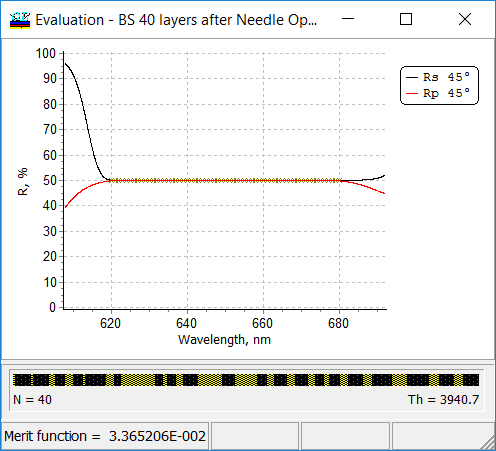The algorithms have been successfully used to obtain winning Design Contest Results 2016!
| Deep Search variant of Needle Optimization should be used in situations when by some reasons you are interested in a design with a good performance, but the number of layers is strictly limited. At each large iteration Deep Search version tries to perform all possible needle insertions and subsequent refinements one by one. Achieved decreases of the merit function are analyzed and as the result the insertion variant providing the largest decrease of the merit function is accepted.
Therefore Deep Search variant is rather time-consuming and therefore is recommended as a choice only for specific problems. Advantages of this method start to appear at rather complicated problems only (more than 50 layers, complicated targets with phase, GD, GDD, etc. requirements). Illustrating example. Designing a beamsplitter:
A 40-layer design with excellent performance has been obtained. |
 |
| After subsequent Design Cleaner (Deep Search) one can obtain a 22-layer beamsplitter with a good spectral performance.
|
22-layer design does not contain thin layers, the thinnest layer is of 50 nm thickness.
|
| This design problem can be considered as an illustrating example only. The Needle Optimization (Deep Search) algorithm in combination with Design Cleaner (Deep Search) can be used for solving really complicated design problems. | The combination of Needle Optimization (Deep Search) and Design Cleaner (Deep Search) has been applied in the course of Design Contest 2016. Winning results have been obtained! See details here. |
Look our video examples at YouTube
OptiLayer videos are available here:
Overview of Design/Analysis options of OptiLayer and overview of Characterization/Reverse Engineering options.
The videos were presented at the joint Agilent/OptiLayer webinar.